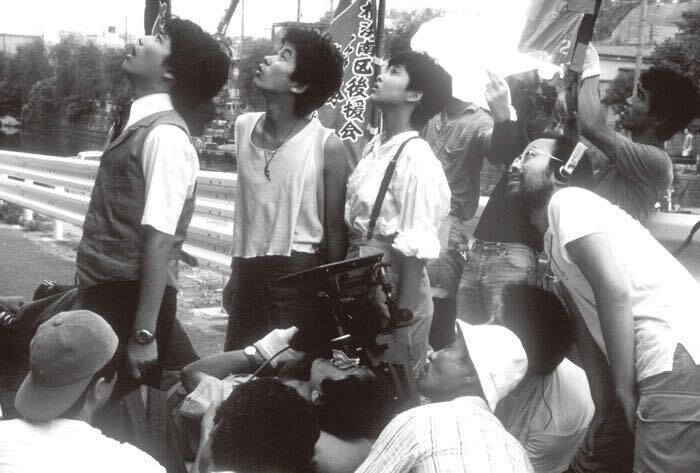Machine Guns, Cocaine, and Fireworks: The Adolescent Films of Shinji Sômai

Written by Joshua Bippert, AFS Creative Careers Intern
This month, as a part of AFS Cinema’s LATES series, Austin Film Society will be presenting Shinji Sômai’s sophomore feature, SAILOR SUIT AND MACHINE GUN. In a time when Japan’s studio systems were collapsing, directors like Sômai — as well as Nobuhiko Obayashi (HAUSU) — were creating independent films that subverted genres within the decaying studio confines. Sômai, in particular, made films that on paper seemed incredibly exuberant but in reality revealed a nuanced mix of melancholy and naturalism. The conventions and themes of his work have been incredibly influential to Japan’s current cinematic landscape for filmmakers such as Shunji Iwai (ALL ABOUT LILY CHOU-CHOU) and Ryûsuke Hamaguchi (DRIVE MY CAR). While he has explored diverse subject matter, much of Shinji Sômai’s films center around young people who blur the line between adulthood and adolescence.
Sômai’s interest in adolescence as subject matter seems, at times, sacred. His characters are brash and exuberant with their cartoonish personas there only to contrast the dark underbellies they traverse. P.P. RIDER (1983) involves three high school students on a befuddling quest to save their school bully, mistakenly kidnapped, from the local yakuza. The ferocity of youth sees the trio overcome shoot-outs and numerous long takes of escapes, including an unbroken five-minute chase across floating logs on a river. Sômai demands an intense physicality from his actors, possibly one reason for his interest in teenagers’ stories. The extreme portrayals of youth depict an effort to resist the nature of growing up, to not lose that freedom and irreverence.

At a cursory glance, the rambunctious youths in his oeuvre seem situated against the morose adults. But, often, these young characters are being pushed to overcome their juvenility. In SAILOR SUIT AND MACHINE GUN (1981), Izumi — a teenage school girl — comes into leadership of a small, makeshift yakuza clan. In MOVING, an elementary school girl must mature quickly due to the messy separation of her parents. Many of the parents of the young protagonists are absent and, when they are present, they are in the process of leaving or escaping. The adults of these stories are messy and complicated, showcasing their own childishness; a weary reminder that they too grew up too fast. It’s only through the kids’ own journeys and juxtaposition with their elders that Sômai reveals the necessity for youth to grow up because of the cyclical ineptitude of adults.

Perhaps most known for his formalism, Shinji Sômai’s use of long takes — like the famous 14-minute opening of LOST CHAPTER OF SNOW: PASSION (1985) or an unflinchingly extended fight in TYPHOON CLUB (1985) — while technically masterful, never feel staged. The prolonged sequences ground our experience of watching his characters. The aforementioned TYPHOON CLUB examines a group of teenagers trapped inside their school as a typhoon rages outside. A little into the night, one male student begins to chase and subsequently attack a female student. The scene may sound like a typical action sequence but, as is often the case with Sômai, description belies complexity: the scene lacks the typical markers of an action movie. Instead, we are brought to witness her assault in incredibly grim, drawn-out detail. The patience that Sômai requires of his audience is something he employs throughout his entire filmography. Yet, in those minutes of unbroken footage, something ephemeral is brought to the surface. Sometimes a shot effortlessly morphs from a walk through a summer festival into a visual existential journey, like in MOVING (1993), and other times the long takes reveal what is being left unspoken: society’s propensity to ignore its problems (as examined in TYPHOON CLUB).
Making your way through Sômai’s films, you cannot escape various recurring motifs; scenes of characters walking through the rain, being drenched by a bucket of water, pushed into a pool, or even a storm lashing against the windows. Water is a symbol of life, and the characters of these films are constantly in motion, moving towards growth or maybe even away from it. The storms surge outside as the teenagers of TYPHOON CLUB battle with their own expectations to grow and eventually fall into the machinations of society. Similarly, Sômai uses song and dance as a release and expression against the social conformity expected of school-age children. P.P. RIDER ends with its heroes dancing — covered in blood and cocaine — out of celebration or simply even a need to be outside of themselves.

The arc of Shinji Sômai’s career showcases not only his talent but his ability to open the door towards traversing genres in Japanese cinema. His beginnings had exaggerated, high stakes, and by the nineties, he was mining familial dramas. But his perspective was never lost. Many of the films of this period, now dubbed the “lost decade of Japanese cinema,” have never been seen or celebrated outside of Japan. However, as the films of Sômai are becoming more widely available, his influence on Japanese independent cinema and other notable Japanese filmmakers — MOVING feeling like a natural precursor to the work of Hirokazu Kore-eda (SHOPLIFTERS, STILL WALKING) — are being reexamined years after his early death in 2001.










